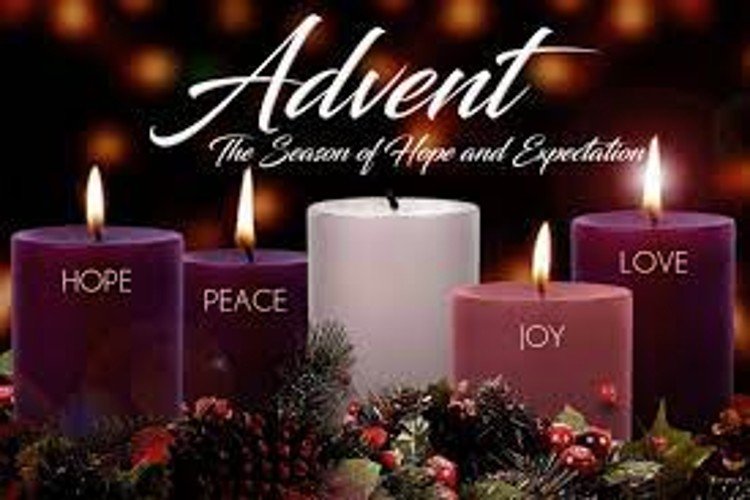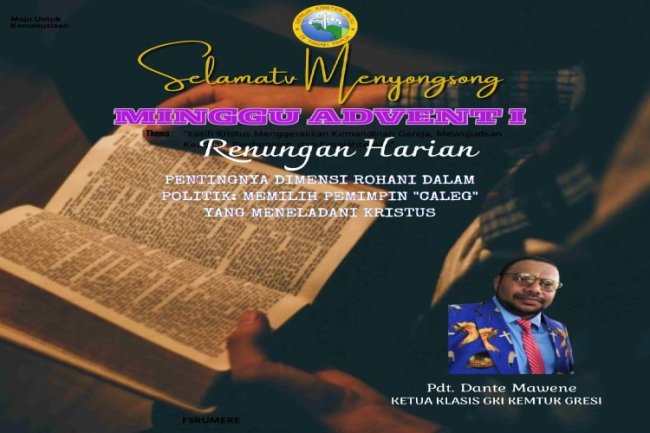ADVENT : A brief explanation of its history and meaning

By: Pdt. Izak M. Rahail, SSi.Th.a.
ADVENT
a.1. The meaning of Advent The word Advent that we know and often mention comes from the Latin word adventus, which means arrival,approach, approaching, and challenging. The term was first used generically in the Roman Empire for the coming of the emperor, who was considered a god, then used by the followers of Christ to declare that for them it was not the emperor, but Christ was King and Lord. In the New Testament, the word Advent is derived from the Greek word parousia, which means the hope of Christ's coming as judge of this world (Matthew 24:39).
a.2. When does Advent start in the church, and how many Sundays does it last? In the early church, there was no Advent celebration; in fact, the Advent celebration first appeared in the Eastern Church (Orthodox) to prepare for the Epiphany that falls on January 6, which is then celebrated as the birth of Jesus. Now the Protestant Church follows the Advent of the Roman Catholic Church, where the Advent celebration began in Gallia at the time of Bishop Perputuus of Tours (490) in the IV century and was celebrated for three weeks starting on December 17. In the V century, preparations were carried out for 40 days starting on November 11. While the practice of Advent has become increasingly institutionalised since the VII century, when Pope Gregory the Great ruled in 590–604 AD, Advent is set for 4 weeks. It is also associated with the Roman Catholic Church, which celebrates Christmas on December 25th; hence, the celebration of the fourth Advent ends on December 24th. Thus, since the XI century (Gregory VII), it has been customary to celebrate Advent for four weeks at the same time to establish Bible reading according to the system of passage 9 (lectio seleca), namely ad te levavi (Psalm 21:1), the Zionist populists (Isa. 30:30), gaudete (Phil. 4:4), and rorate caeli (Isa. 45:8).
a.3. Advent as a time of remembrance and hope When we celebrate Advent, then we are actually celebrating two things related to the coming of the Lord Jesus Christ: First, Advent reminds us of the historical-sacramental dimension of salvation, namely the fact that he was born into the world, namely his birth in Bethlehem; this is the first coming. That is one of the other reasons why the celebration of Advent is also celebrated before the birth of the Lord Jesus. Second, Advent contains an eschatological dimension, namely the waiting for the return of the Lord Jesus for the second time. Well, at this time, the Church is enriched with two appreciations in the liturgy, namely: Advent I–II, or until December 16, emphasises the eschatological aspect of the parousia. The second part, Advent III-IV, or from December 17, emphasises the aspect of the birth of God, that is, during the anamnesis (remembrance) and incarnation.
a.4. Themes and emphasis on the four weeks of Advent Advent I, filled with the theme of the attitude of the Church in anticipation of his coming that liberates mankind, It is usually a reading taken from OT Isaiah 2:1–5, Isa. 64:1–9, and Jer. 33:14–16. In the New Testament, Matt. 24: 36-44; MK.13; 24-37; LK.21:25-36; Romans 13: 11-14, 1 Cor.1:3-9; 1 Thess.3:9-13 Advent II, The main theme of the Second Advent is the conversion to a new heaven and a new earth for all nations, all mankind, in accordance with his justice. The reading that is often noticed is: Old Testament, Yes. 11:1–10; Isa. 40:1–11; Mal. 3:1-4. New Testament Romans 15:4–12; 2 Pet. 3:8–15a; Philippians 1:3–11; Matt. 3:1–12; MK. 1:1–8; Luke 3:1-6 Advent III, This week is an invitation to prepare the way for the coming of the Lord. His coming does not coincide with his birth but can be seen as his second coming. Note: The Old Testament, Isa. 35:1–10; Isa. 61:1-4, 8–11; Zephaniah 3:14–20. The New Testament, Matt. 11:2–11; JN. 1:6–8, 19–28. Luke 3:7–18; Jas. 5:7–10; 1 Thess. 5:16–24; Philp. 4:4–7Advent IV: The focus of the service on the fourth Sunday of Advent leads to the birth of the Lord in Bethlehem. Usually a reading in the week is from the Old Testament: Isaiah 10–16; 2 Samuel 7:1–11, 16; Micah 5:2–5a. The New Testament, Matt. 1:18–25; Luke 1:26–55Romans 1:1–7; Romans 16:25–27; Hebrews 10:5–10 Here we see that the advent period is really the weeks where we are in an atmosphere of waiting, hope, and introspection. This is a period of calm, and at this time, it should be the advent period that is really celebrated as a time of remembrance and hope. That is why all believers should refrain from celebrating Christmas quickly at this time; do not sing Holy Night songs or come together because this completely obscures the meaning of Advent.
a. 5. Is there an Advent decoration tradition? Like Christmas, we have the custom of putting up Christmas trees and Christmas candles. At this time, we meet with symbols that follow the practice of Advent, such as a Corona circle or Advent circle in the form of still green leaves( usually spruce twigs or leaves), pine leaf krans, four candles, and red and purple ribbons. This candle is usually run every week; from the first week of one candle, the second candle, and the fourth week, all the candles are lit. In this tradition, there are several meanings. 1. The advent circle, or corona, symbolises the wait for eternal life. It also symbolises unity. 2. Advent candles symbolise the light of God. 3. The colour green symbolises life and hope. 4. A purple ribbon symbolises repentance. 5. The colour red symbolises love. 6. Four candles symbolise four weeks. The candles lit in this week of Advent are part of the Jewish influence; that is, in the feast of the consecration of the Temple (Hanukkah) candles, palm leaves, and light decorations are used. Hanukkah is celebrated for eight days. Eight candles are lit one at a time every day until there are even eight candles on the eighth day. The colour of the pulpit, or the colour of Advent, is purple. This colour symbolises repentance, concern, death, or mourning.
a.6. Meaning of Advent What does Advent really mean? First, security in human history. Advent reminds us that the God we look forward to is a God who has entered human history. It was Jesus of Nazareth who was born in a manger in an animal pen. In Jesus, God is at work. Second, the fullness of salvation. The fullness of our salvation occurs at the end of time. We are still waiting for the end times. Our whole life, then, is a long wait towards that fullness. Third, the message. As redeemed people of Jesus Christ, we are also sent to preach the good news to others.
to be continued...........
Source : What Is Advent Season? A Closer Look at the Christian Tradition (ourlittleroses.org)
What's Your Reaction?




















